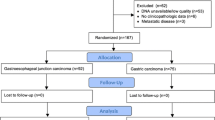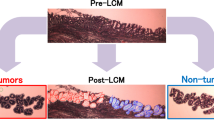Abstract
Objectives: We investigated p53 gene mutations in advanced gastric cancers by direct DNA sequencing, in order to determine the frequency of mutations in gastric cancers having different epidemiological backgrounds, tumors of the cardia were compared with those arising in the antrum or corpus. Intestinal type cancers were compared with diffuse or other histologic types. We have chosen to assess the frequency of mutations solely based on DNA sequencing.
Methods: Paraffin embedded tissues from 100 gastric cancers were evaluated. The mutational status of the p53 gene in exons 5 through 9 were determined by direct sequencing of PCR products.
Results: Mutations in exons 5, 6, 7 and 8 were found in 35 of 100 (35%) stomach cancers. One tumor had mutations in both exons 5 and 8. No mutations were detected in exon 9. p53 gene mutations were significantly more frequent in cancers of the cardia (19/35; 54%) than the antrum and corpus (16/65 (25%)) (p ≤ 0.005). p53 mutations were more frequent in intestinal type cancers (28/67; 42%) than diffuse cancers or other histologic types of cancer (7/33; 21%), but the difference was not statistically significant.
Conclusions: Cancers of the cardia more frequently contain p53 mutations than do antral and corpus cancers, suggesting that cancers in the proximal and distal stomach evolve through different molecular pathways.
Similar content being viewed by others
References
Landis SH, Murray T, Bolden S, Wingo PA (1998) Cancer Statistics, 1998. CA Cancer J Clin 48: 6-29.
Parkin DM, Muir C, Whelan SK, Ga OYT, Ferlay J, Powell J, eds. (1992) Cancer Incidence in Five Continents. Volume 6, Lyon: IARC Publications No. 120, 1992.
Correa P (1988) A human model for gastric carcinogenesis. Cancer Res 48: 3544-3560.
Nomura A, Stemmermann GN, Chyou P-H, Kato I, Perez-Perez GI, Blaser M (1991) Helicobacter pylori and its relation to stomach cancer in a population of Japanese Americans in Hawaii. N Eng J Med 325: 1132-1136.
Nomura A (1996) Stomach cancer. In: Schottenfeld D, Fraumeni JF, eds. Cancer Epidemiology and Prevention, 2nd edn. Oxford: Oxford University Press, pp. 707-724.
Hansson LE, Engstrand L, Nyren O, Lindgren A (1995) Prevalence of Helicobacter pylori infection in subtypes of gastric cancer. Gastroenterology 109: 885-888.
Munoz N, Asvall J (1971) Time trends of diffuse and intestinal types of cancer in Norway. Int J Cancer 8: 144-157.
Zheng T, Mayne ST, Holford TR, Boyle P, Liu W, Chen Y, Mador M, Flannery J (1993) The time trend and age-period-cohort effects on incidence of adencarcinoma of the stomach in Connecticut from 2955-89. Cancer 72: 330-340.
MacDonald WC, MacDonald JB (1987) Adenocarcinoma of the esophagus and/or cardia of the stomach. Cancer 60: 1094-1098.
Seruca R, David L, Holm R, Nesland JM, Fangan BM, Castedo S, Sobrinho-Simoes M, Borresen AL (1992) p53 mutations in gastric cancer. Br J Cancer 65: 708-710.
Kim JH, Takahashi T, Chiba I, Park JG, Birrer MJ, Roh JK, Lee HD, Kim JP, Minna JD, Gazdar AF (1991) Occurrence of p53 gene abnormalities in gastric carcinoma tumors and cell lines. J Natl Cancer Inst 83: 938-943.
Yamada Y, Yoshida T, Hayashi K, Sekiya T, Yokota J, Hirohashi S, Nakatani K, Nakano H, Sugimura T, Terada M (1991) p53 gene mutations in gastric cancer and in gastric cancer cell lines derived from metastases. Cancer Res 51: 5800-5805.
Semba S, Yokozaki H, Yamamoto S, Yasui W, Tahara E (1996) Microsatellite instability in precancerous lesions and carcinoma of the stomach. Cancer 77: 1620-1627.
Renault B, van den Broek M, Fodde R, Wijten J, Pellegat NS, Amadori D, Kahn PM, Ranzani GN (1993) Base transitions are the most frequent genetic changes at p53 in gastric cancer. Cancer Res 53: 2614-2617.
Uchino S, Noguchi M, Ochiai A, Saito T, Kobayahi M, Hirohashi S (1993) p53 mutation in gastric cancer: Model for carcinogenesis is common to gastric and colorectal cancer Int J cancer 54: 759-764.
Imazeki F, Omata M, Nose H, Ohto M, Isono K (1992) p53 mutations in gastric and esophageal cancers. Gastroenterology 103: 892-896.
Yokozaki H, Kuniyasu H, Kitadai Y, Nishimura K, Todo H, Ayhan A, Yasui W, Ito H, Tahara E (1992) p53 point mutations in primary gastric carcinomas. J Cancer Res Clin Oncol 119: 67-70.
Motojima K, Furui J, Kohara N, Ito T, Kanematsu T (1992) Expression of p53 protein in gastric carcinomas is not independently prognostic. Int J Cancer 59: 859-862.
Martin HM, Filipe MI, Morris RW, Lane DP, Silvestre F (1992) p53 expression and prognosis in gastric carcinoma. Int J Cancer 50: 859-862.
Tamura G, Kihana T, Nomura K, Terada M, Sugimura T (1991) Detection of p53 mutations in primary gastric cancer by cell sorting and polymerase chain reaction single strand polymorphism analysis. Cancer Res 51: 3056-3058.
Tolbert DM, Noffsinger A, Miller MA, De Voe G, Stemmermann GN, MacDonald JS, Fenoglio-Preiser CM (1999) p53 immunoreactivity and single strand polymorphism analysis often fail to predict p53 mutational status. Modern Pathology 12: 54-60.
Lauren T (1965) The two histologic main types of gastric carcinoma: diffuse and so-called intestinal type carcinoma. Acta Pathol Microbiol Scand 64: 31-49.
AJCC Cancer Staging Manual, 5th edn (1998) Philadelphia: Lippincott-Ravan, pp. 71-75.
Zhang Z-F, Kurtz RC, Karpeh M Jr, Yu G-P, Gargon N, Fein JS, Georgopoulos SK, Harlap S (1996) Adenocarcinoma of the esophagus and gastric cardia: Medical conditions, tobacco, alcohol and socioeconomic factors. Cancer Epidemiol Biomarkers Prev 5: 761-768.
Gleeson CM, Sloan JM, McGuigan JA, Ritchie AJ, Russell SEH (1995) Base transitions at CpG dinucleotides in the p53 gene are common in esophageal adenocarcinoma. Cancer Res 55: 3406-3411.
Hamelin R, Flejou JF, Muzeau F, Potet F, Laurent-Puig P, Fekete F, Thomas G (1994) TP53 gene mutations and p53 protein immunoreactivity in malignant and premalignant Barret's esophagus. Gastroenterology 107: 1012-1017.
Neshat K, Sanchez CA, Galipeau PC, Blount PL, Levine DS, Joslyn G, Reid BJ (1994) p53 mutations in Barrett's adenocarcinoma and high grade dysplasia. Gastroenterology 106: 1589-1595.
Schneider PM, Casson AG, Levin B, Garewal HS, Hoelscher AH, Becker K, Dittler HJ, Cleary KR, Troster M, Siewert JR, Roth JA (1996) Mutations of p53 in Barrett's esophagus and Barrett's cancer: prospective study of ninety-eight cases. J Thor Cardiac Surg 111: 323-331.
Solcia E, Fiocca R, Luinetti O, Vilani L, Padovan L, Calistri D, Ranzani GN, Chiavalli A, Capella C (1996) Intestinal and diffuse gastric cancers arise on a different background of Helicobacter pylori gastritis through different gene involvement. Am J Surg Path 20: S8-S22.
Farrow DC, Vaughn TL, Hansten PD, Stanford JL, Risch HA, Gammon MD, Chow WH, Dubrow R, Ahsan H, Mayne ST, Schoenberg JB, West AB, Rotterdam H, Fraumeni JF, Bolt WJ (1998) Use of aspirin and other nonsteroidal anti-inflammatory drugs and the risk of esophageal and gastric cancer. Cancer Epidemiol Biomarkers Prev 7: 97-102.
Martin-de-Argila C, Boixida D, Redondo I, Alverez I, Gisbert JP, Garcia Plaza A, Canton R (1997) Relation between histologic subtypes and location of gastric cancer and Helicobacter pylori. Scand J Gastroenterol 32: 303-307.
Chow W-H, Blaser M, Blot W, Gammon MD, Vaughn TL, Risch HA, Perez-Perez GL, Schoenberg JB, Stanford JL, Rotterdam H, West AB, Fraumeni JF (1998) An inverse relation between cagA + strains of Helicobacter pylori infection and risk of esophageal and gastric cardia adenocarcinoma. Cancer Res 58: 588-590.
Labenz J, Blum AL, Bayerdorffer E, Meining A, Stolte M, Borsch G (1997) Curing Helicobacter pylori infection in patients with duodenal ulcer may provoke reflux esophagitis. Gastroenterology 112: 1442-1447.
Jaup B (1997) Gastroesophageal reflux after cure of H. pylori infection. Gastroenterology 113: 2019.
Author information
Authors and Affiliations
Rights and permissions
About this article
Cite this article
Tolbert, D., Fenoglio-Preiser, C., Noffsinger, A. et al. The relation of p53 gene mutations to gastric cancer subsite and phenotype. Cancer Causes Control 10, 227–231 (1999). https://doi.org/10.1023/A:1008899111209
Issue Date:
DOI: https://doi.org/10.1023/A:1008899111209




